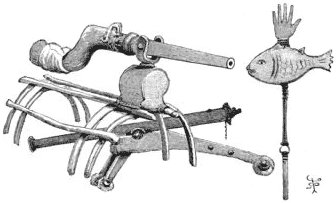Съвсем случайно прочетох за това. Артилерия на камили, при това много успешна! От 18-ти до 20-и век, Персия, Афганистан, Индия и пр.
(ето къде е коренът на "тактикалите" /пикапи с картечници/леки оръдия!!!/ - никой не открива топлата вода )
)


А това е камила с "Гатлинг"

High firepower on camel back. 1861-62
(ето къде е коренът на "тактикалите" /пикапи с картечници/леки оръдия!!!/ - никой не открива топлата вода
 )
)
A zamburak or zumbooruk was a specialized form of mobile artillery from the early modern era. The operator of a zumbooruk is known as a zamburakchi or zumboorukchee. The weapon was used by the Gunpowder Empires, especially the Persian empires of the Safavids & Afsharids due to the ruggedness of the Iranian plateau which made transportation of heavy cannon problematic.
The zamburak became a deadly weapon in the eighteenth century. The Afghans used it to deadly effect in the Battle of Gulnabad where they routed a Persian army. However the most successful application of the zamburak would take place in the Naderian Wars when the military genius Nader Shah would utilise a zamburak corps in conjunction to a regular artillery corps (consisting of conventional cannon) to devastating effect in numerous battles such as at Mihmandust, Baghavard and Karnal.
The zamburak became a deadly weapon in the eighteenth century. The Afghans used it to deadly effect in the Battle of Gulnabad where they routed a Persian army. However the most successful application of the zamburak would take place in the Naderian Wars when the military genius Nader Shah would utilise a zamburak corps in conjunction to a regular artillery corps (consisting of conventional cannon) to devastating effect in numerous battles such as at Mihmandust, Baghavard and Karnal.

The Zamburaks where a special branch of Camel Cavalry of the legendary Mughal Empire (1526-1858 AD), an Islamic Kingdom that once ruled nearly all of the Indian Sub-continent. These riders rode camels which where armed with a specialized swiveling cannon called a Shaturnal (Camel Barrel), a small falconet cannon which was fired after the camel was lowered to its knees and had its legs tied together. When fired in numbers, these cannons could deliver a savage volley, and were effective against charging cavalry. If enemy troops came at the Zumbaraks at close quarters, the riders would fight back with daggers (like the Katar), and swords (the Tulwar, Shamshir, etc), and if the enemy rode horses unaquainted with Camels, their horses would most likely panic (horses are afraid of Camels).
The idea of firing Cannons, no matter how small, off the backs of Camels, may seem ludicrous to some in the modern world, yet Camel-Cannon-cavalry like the Zamburak was so successful in battle that they where still used in India's military until the 20th century. Cannon bearing Camels both outnumbered and outlasted their comrades in arms, Cannon Mounted Elephants, the last of which saw their guns finally silenced in 19th century Burma/ modern Myanmar.
The idea of firing Cannons, no matter how small, off the backs of Camels, may seem ludicrous to some in the modern world, yet Camel-Cannon-cavalry like the Zamburak was so successful in battle that they where still used in India's military until the 20th century. Cannon bearing Camels both outnumbered and outlasted their comrades in arms, Cannon Mounted Elephants, the last of which saw their guns finally silenced in 19th century Burma/ modern Myanmar.
А това е камила с "Гатлинг"


High firepower on camel back. 1861-62
Nope, that’s not a Photoshop job or an illustration for the latest alternate history book. During the mid 1850s, you really did find camel-mounted hand-cranked Gatling guns.
The innovation followed the Turkish zamburak tradition of camel-mounted weaponry — first the crossbow, then power guns and eventually rapid-fire Gatling guns mounted on a swivel.
According to “Mughal Warfare: Indian Frontiers and Highroads to Empire 1500–1700,” you didn’t fire one of thee bad boys while the camel was still afoot. Instead, the zamburak soldier made the animal kneel, then fastened each leg with a cord to keep it from moving.
According to Bibliomania, the name “zamburak“ liekly refers to the “twang” of a cross-bow at the moment of discharge, thus calling back to its pre-gunpowder roots.
The innovation followed the Turkish zamburak tradition of camel-mounted weaponry — first the crossbow, then power guns and eventually rapid-fire Gatling guns mounted on a swivel.
According to “Mughal Warfare: Indian Frontiers and Highroads to Empire 1500–1700,” you didn’t fire one of thee bad boys while the camel was still afoot. Instead, the zamburak soldier made the animal kneel, then fastened each leg with a cord to keep it from moving.
According to Bibliomania, the name “zamburak“ liekly refers to the “twang” of a cross-bow at the moment of discharge, thus calling back to its pre-gunpowder roots.




 . Иначе всички там ползват успешно слонове, но като артилерийски влекачи. Наистина, нищо ново под слънцето - особено за войната.
. Иначе всички там ползват успешно слонове, но като артилерийски влекачи. Наистина, нищо ново под слънцето - особено за войната.












Comment